Honestly, the idea of a vertical indoor jungle is just as appealing to your tropical plants as it is to you and me (and trust me, that’s a lot).
So many of the exotic houseplants we know, and love can really benefit from having something to attach to and climb up.
Bigger leaves, stronger fenestrations, healthier plants – the list goes on.
In fact, some species require it in order to mature.
Without tree trunks in the home, moss poles are the next best thing. They’re a simple, versatile, and effective means to support your tropical climbers and unruly growers alike.
In this article, we’ll take you through the various kinds of moss pole and show you how to use them with a hands-on demonstration of how we attached our Mini Monstera.
Let’s get into it.
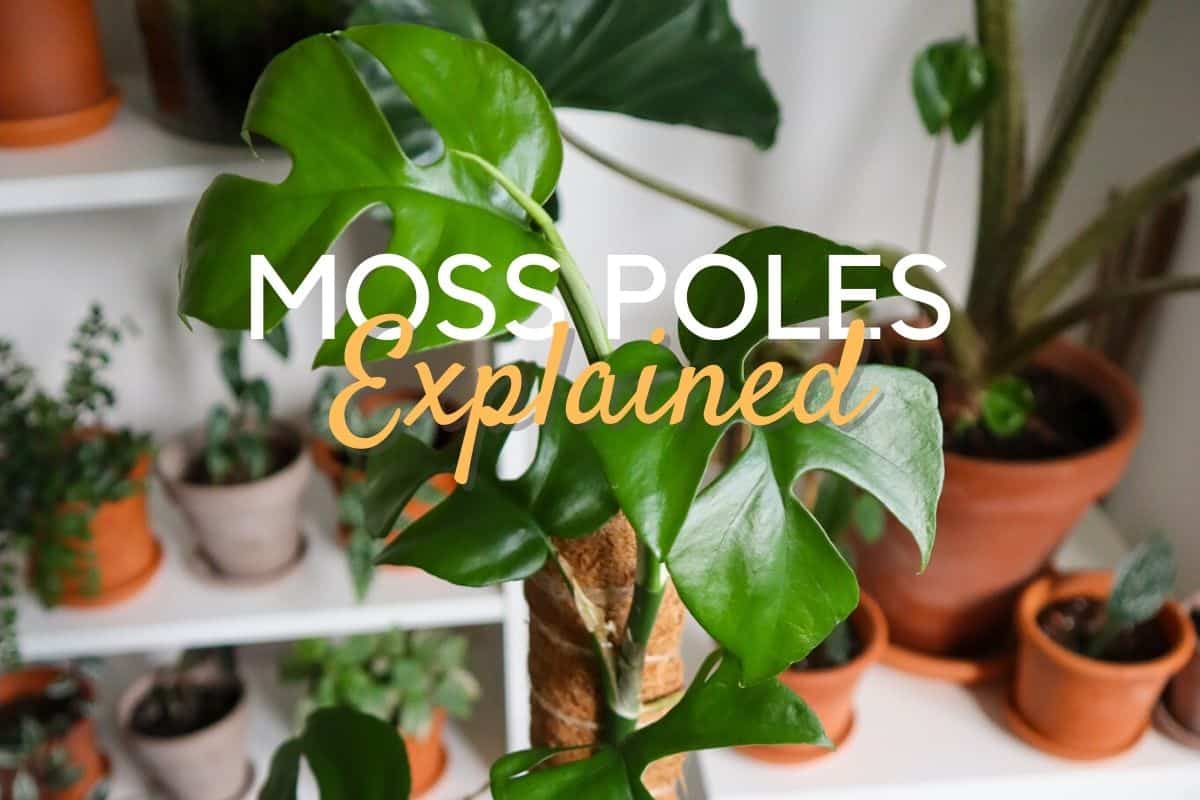
Terrarium Tribe is reader-supported. When you purchase through links on our site, we may earn an affiliate commission (at no further cost to you). 💜
What is a Moss Pole? (and Why Do Some Plants Need Them?)
You’d think it’s basically a pole made of moss, and you’d be right… some of the time.
These days, it’s a loose term used in the horticultural space to describe any vertical pole designed to support plants with some sort of fibrous material.
Moss is still used for sure, but these days, coco coir poles are probably more common (more on the types of moss poles later).
As you might expect, climbing vines are the prime candidates for attaching to moss poles.
Aroids (e.g. Monstera, Philodendron, and Pothos) and similar tropical epiphytic species are a common choice, but anything that’s used to climbing trees is going to appreciate a moss pole.
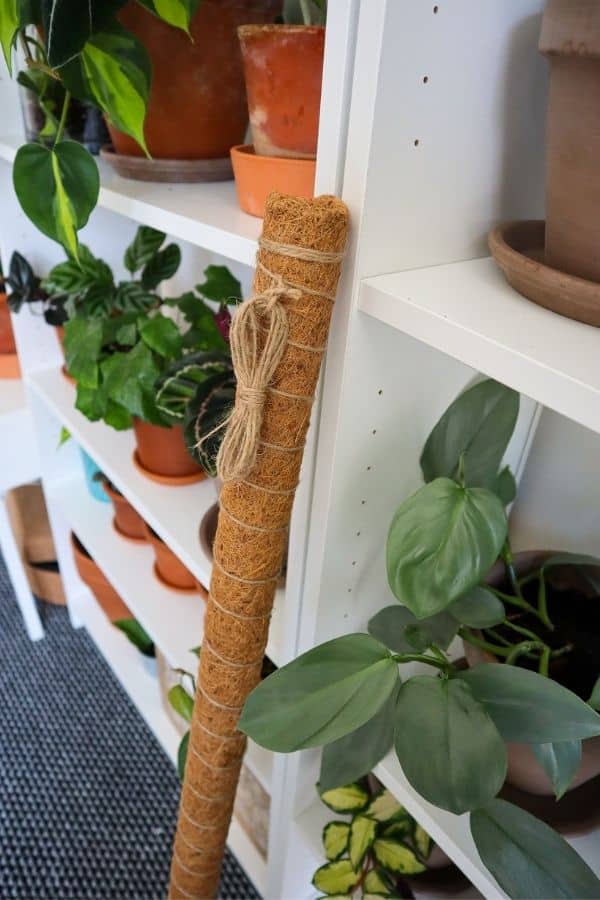
It’s all about replicating their natural environment and supporting the plants – physically and figuratively – so they can become their best plant selves.
Sounds like something right out of a self-help book, but there you go.
Benefits of a Moss Pole
- They provide support for epiphytic plants to grow upwards. The aerial roots of vining species can easily attach to the fibrous material, securing the plant and encouraging its growth.
- They can supply moisture to the plant. Moss poles are always made with a water-retentive material, so watering/spraying the pole will allow it to store some moisture for the plants’ aerial roots to access.
- They often help plants progress through to maturity. Taller plants think they’re closer to the sunlight at the top of the rainforest canopy and make changes to capitalize on that. Potentially leading to larger plants, larger leaves, fenestrations, and more.
- They’re a space-efficient solution. I get it; we’re all low on counter space for new plants, but climbing plants can be trained to occupy vertical space instead of horizontal.
- They can make unruly plants look really good. We’ve all got that one vining species that looks like all stem and no foliage sometimes. Integrating the stem of the plant with the central pole visually removes the stem and highlights the foliage.
- You can increase the shape of the plant to increase the density of the foliage. By wrapping the plant around a moss pole, you’re able to effectively bring leaves closer together – shaping the plants’ foliage as you see fit. Though our Rhaphidophora tetrasperma here has such a thick/stiff stem, it’s not easy to wrap around the pole.
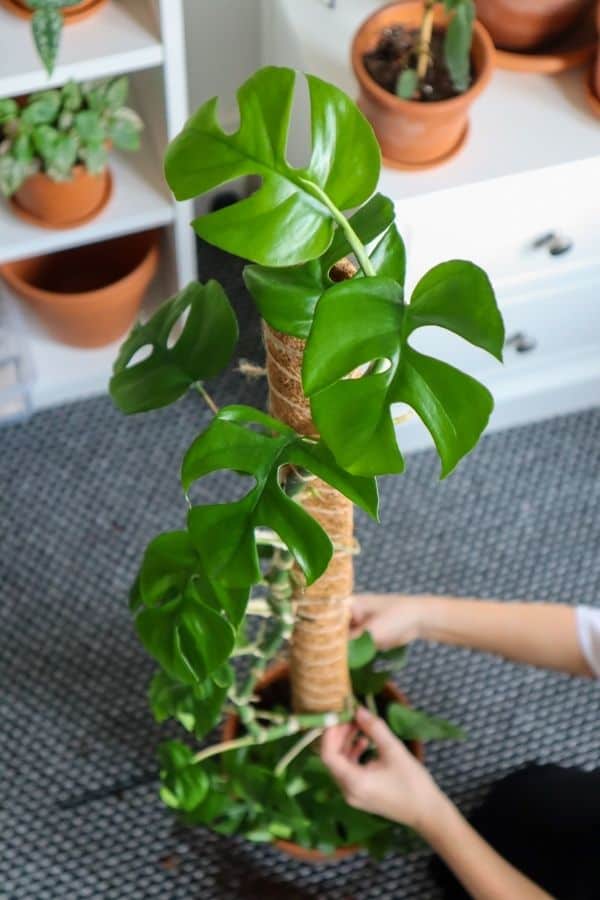
How to Use a Moss Pole for Climbing Plants
Getting Started
Just like education, there’s a good reason to start early when it comes to training on moss poles.
You’ll need to “plant” the base of the pole itself in the substrate, and if you want it central, you’re going to need to get it right in close to the base of the plant.
Guess what else is there in there with mature plants?
Bingo! The plant roots system you’re about to maim… That’s why it’s worth getting your moss pole in early – even for small and juvenile plants – so it can learn to live with the support from the beginning.
However, if (like most people) you already have a big plant that needs a moss pole, don’t fret.
We can make it work.
After all, we can’t always be prepared, and I’m well aware of how easy it is to come home with spontaneous new plant purchases.
It’s much easier to add a new moss pole to a plant when you’re re-potting it. You can’t simply jam a pole into that mass of roots and substrate.
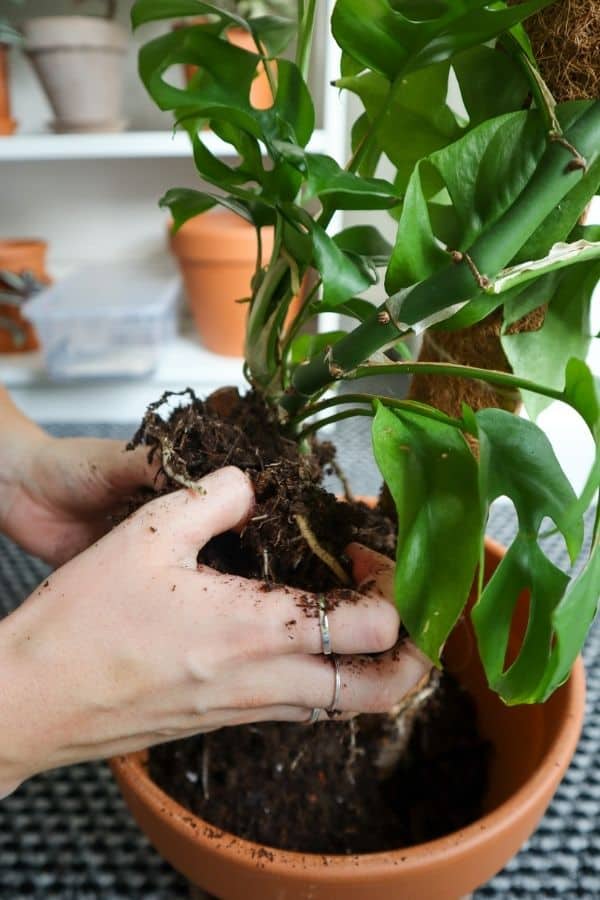
So, remove your plant first, try to gently separate the roots as much as you can until you can get your pole nice and flush with the base of the plant – then plant them in together.
Securing them with plenty of substrate.
It can really help to soak your moss pole thoroughly in water first, too, though we didn’t this time (as this is messy enough with a camera).
How to Attach Plants
Plants are triggered to attach by contact with the pole surface, which is why we bind them closely.
Vines are pretty straightforward, and for more shall we say… chaotic plants, you’ll generally want to target the larger stems for attachment.
That way, the plant is fully supported, and the smaller stems are free to show off their foliage.
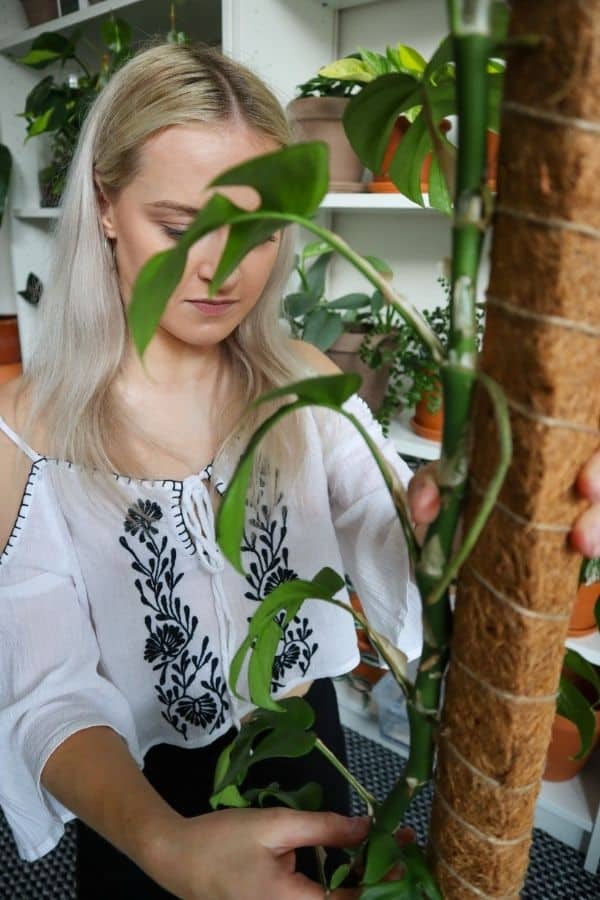
You attach plants directly to the moss pole in a few ways.
#1. Pin them using metal staples. I’ve seen these sold under the name of “moss pole pins” but they’re essentially just a U shape that you can press into the pole, trapping the stem in the middle.
#2. Wrap them with twine or wire. Tying a loop around the outside of the stem and pole together and then tightening it to bind them together. Twine is my preferred method – I like the rustic look.
#3. Velcro straps or cable ties. It’s the same deal as the twine, really. It doesn’t look as natural, but when you’re dealing with big and heavy plants, the added security can help.
#4. Wrap the plant itself. Some plants need minimal intervention in attaching to the moss pole. I’ve successfully attached plants just by wrapping the vine gently around the pole, making sure the aerial roots had something to grip.
Try to attach them in such a way that the plant nodes are the parts touching the moss pole. That’s where the aerial roots will develop from, so the easier you can make it for the plant, the better.
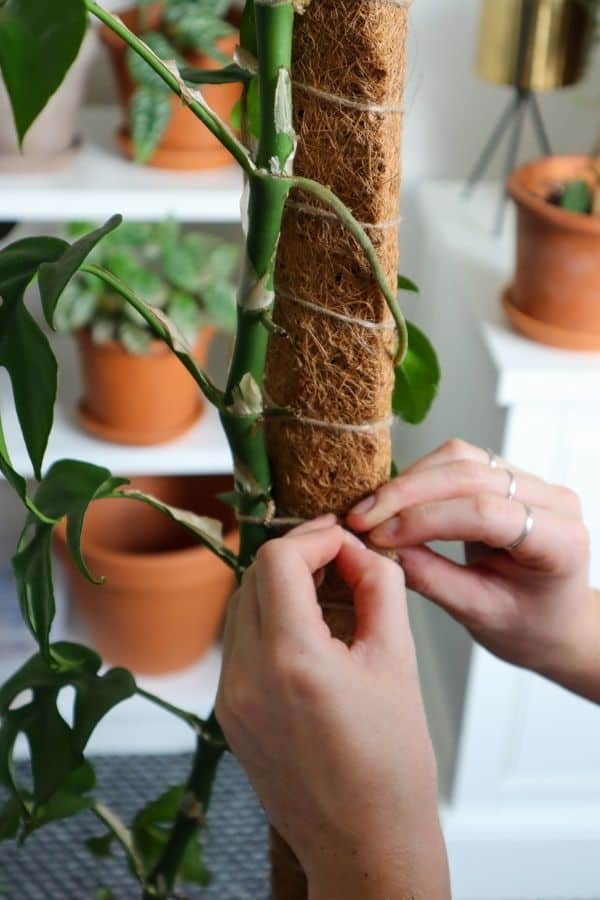
How to Train Plants to Climb
Once a plant has initially attached, you’ll likely have to continue to guide your plant up the moss pole for a while.
Remember, you can help them root – and therefore bind – by misting the plant regularly and providing as much humidity as possible.
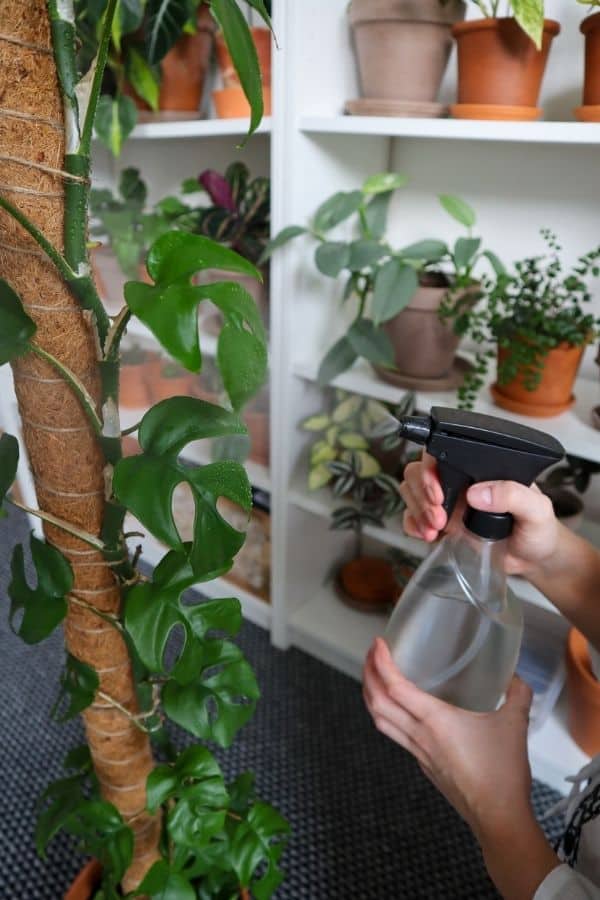
Eventually, you can expect your plant to get the message, and it’ll take over the process of climbing itself.
You can also remove the bindings from the lower sections if they’ve securely rooted themselves.
What to do When Plants Reach the Top of the Moss Pole?
Moss poles are sometimes designed to be extendable, or you can probably adapt whatever you’ve got to add some extra height.
You can often just lop off the tip of your existing moss pole and drop in another pole with a slightly thinner diameter. Provided the base of the extra moss pole is long enough, it should lock it securely into place.
Alternatively, it could simply be time to propagate your champion grower.
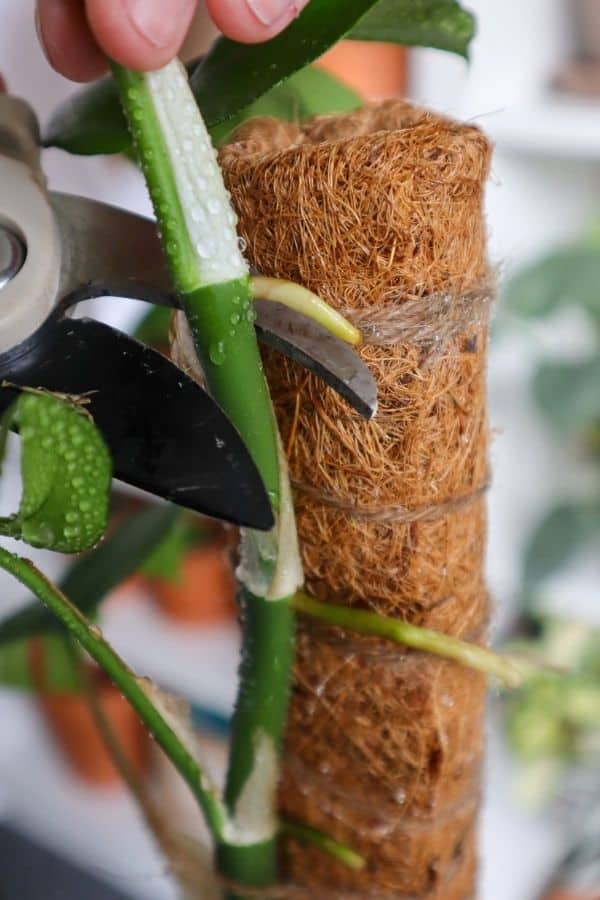
You can keep removing the top of your plant, so it’s going to continue to re-grow that section with bigger and bigger leaves.
Types of Moss Pole
Sphagnum Moss Pole
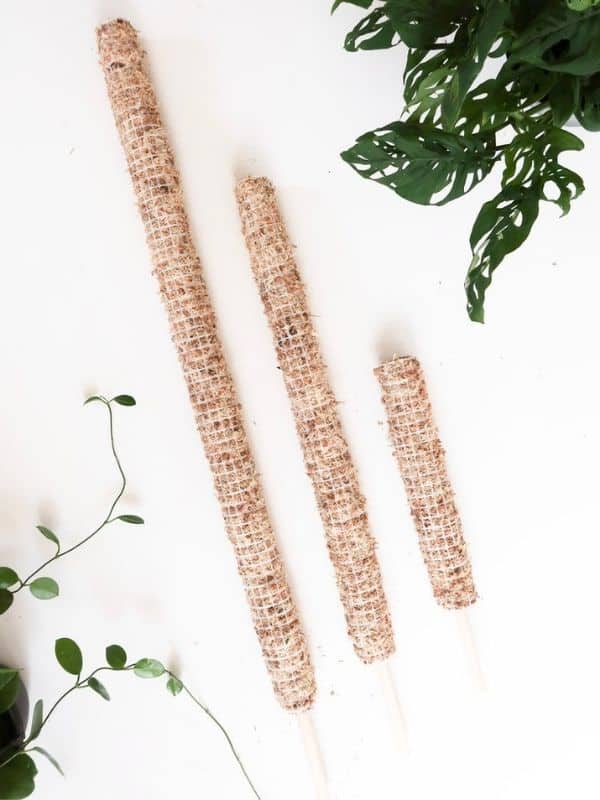
The most traditional moss poles are filled with preserved sphagnum moss and bound with twine or wire.
Sphagnum moss makes for a great support material as it is incredibly water-retentive and highly resistant to rot, and its fluffy consistency is easy for plants to root into.
You can also get live sphagnum moss poles.
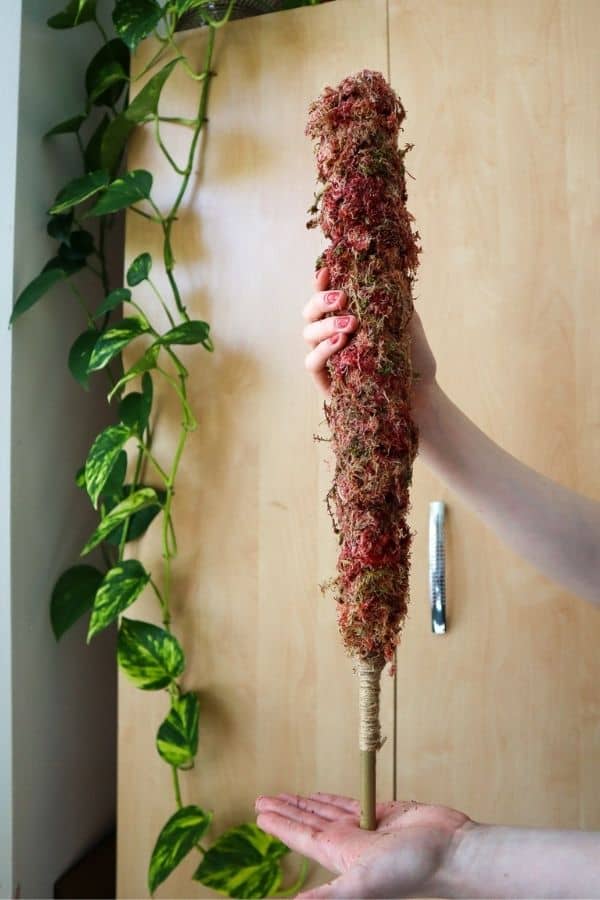
They are largely the same in terms of performance and can look really fresh and dynamic, but they’re hard to keep that way, in my opinion.
I sprayed my live moss pole daily and kept it in a room that averages 75%+ humidity, and it would dry out all the time.
Despite their water retention, I still find it a challenge to keep a sphagnum moss pole moist consistently.
Good for plants that need lots of consistent moisture and fully epiphytic plants that don’t root into a substrate.
👉 See sphagnum moss poles on Etsy
Coco Coir Pole
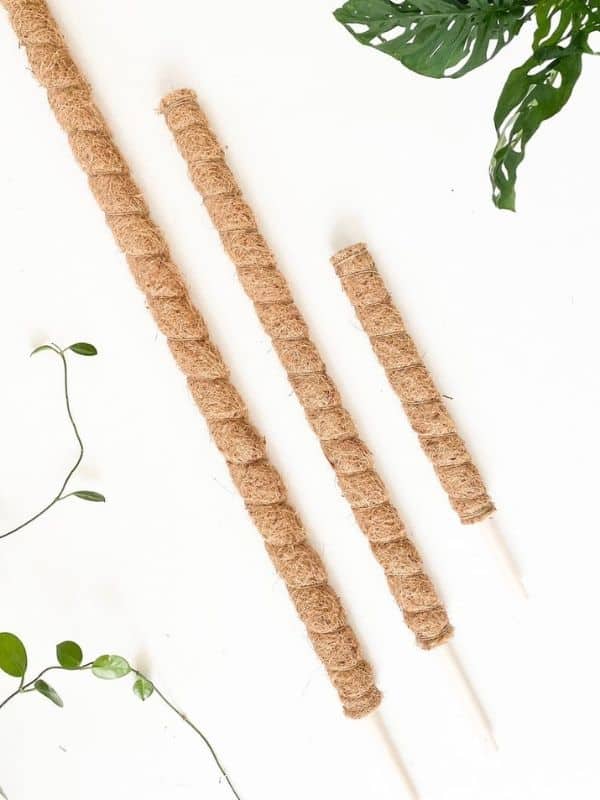
Coco coir is a material made from the husks of coconuts and has many of the same qualities as dried sphagnum moss.
The coconut fiber is still water-retentive (though not as much as sphagnum) and is also resistant to breaking down.
Arguably, where it really shines is its availability and sustainability.
Which is probably why it’s fast becoming the de-facto material of choice for moss poles.
These days, this is what I prefer to use where I can.
Sphagnum moss still has its uses, but for plants that mostly need moss poles for support rather than for nutrients, coco coir should be more than enough.
Best for Aroids.
- Epipremnum – e.g. Cebu Blue Pothos
- Philodendron – e.g. Philodendron micans
- Monstera – e.g. Monstera siltepecana
👉 See coco coir moss poles on Etsy
Tree Fern Fiber Pole
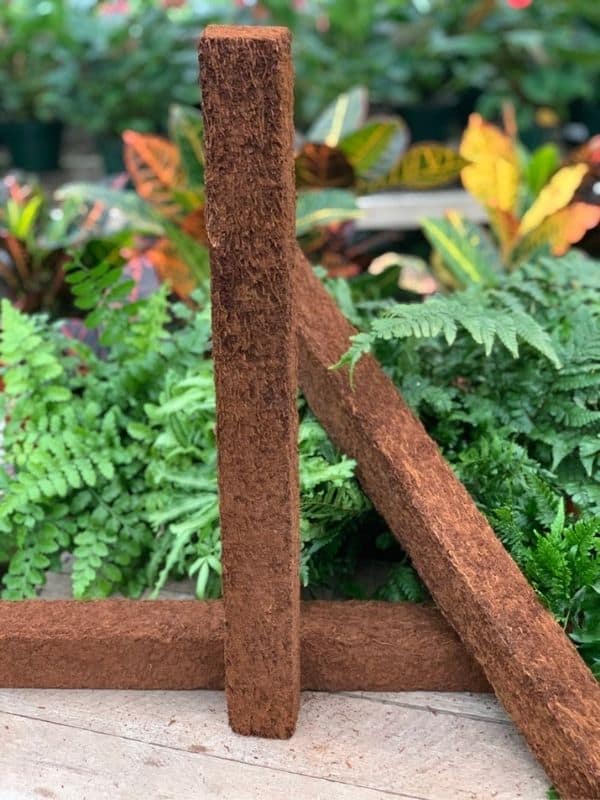
It’s not really a pole per se; tree fern fiber is instead sold as a “totem.”
Which is another word for a squarish pole in this context.
It’s certainly not sold under the guise of a moss pole (this is my own interpretation, really), but they serve similar functions, and I’m a big fan of the stuff for epiphytes of all kinds.
The material is less of a tightly packed cord like sphagnum or coir and more a condensed block of fibers.
Which makes it harder for aerial roots to penetrate, but they can still attach themselves just fine.
It’s probably not suitable for huge plants that you’re going to need to firmly attach aerial roots to (stabbing the roots through is a common method that won’t work here), but they’re great for more delicate vines to find a foothold.
Lastly, like sphagnum moss, there are some sustainability concerns here, but if you make sure you buy New Zealand tree fern fiber (from the Fernwood brand) you can be sure you’re doing right by the environment.
Best for delicate climbing and trailing plants.
- Ficus – e.g. Ficus pumila
- Peperomia – e.g. Peperomia prostrata
- Dischidia – e.g. Dischidia ovata
👉 See tree fern fiber poles on Etsy
Making a DIY Moss Pole
If you’re in need of lots of moss poles (and you fancy a bit of crafts work), then making your own DIY moss poles is definitely an option.
It’ll definitely work out cheaper if you can materials in bulk.
You’ll need:
- A central pole – PVC pipes are commonly used, but you can also use a wooden stake.
- A fibrous material – You can either bind loose pieces of moss or, if you’re using coir, you can also find it in sheets that you can simply wrap around the pole. We sell loose coco coir on the store.
- A binding material – You can use fishing wire, a wire mesh wrap, and twine. Anything that’s not going to rust or rot.
As far as DIY projects go, this is an easy one.
Something I’m planning to do very soon.
Frequently Asked Questions
Any type of climbing plant is going to benefit from a moss pole to help support its natural growth pattern. Plus, any large or unruly indoor plants that just need stabilizing.
Moss poles function best when they’re wet, as the moisture encourages aerial root growth and nourishes the plants.
You can absolutely make your own moss pole. It’s a very simple DIY project that requires very few materials and only basic skills.
Give your Monstera plants a moss pole as early as possible. It’ll be much easier to add the pole without damaging the roots, and the support will help the plant grow and develop mature leaves faster.
Bamboo stakes are a simple and effective alternative to moss poles for plants that just need some extra support.
Coco coir makes an excellent alternative to sphagnum or sheet moss for moss poles. It’s less water-retentive but still provides a stable material that’s easy for plants to root into.
Over to You
There you have it: everything you need to know about moss poles for plants.
Now, how about finding some tropical terrarium vines to go with them?

I have been all over the internet, putting literally hours into research while looking for information on the different “moss poles”, what would work best for my various vining plants (pothos, monstera, syngoniums, philodendrons) in addition to how to train them and this is the VERY BEST guide I have found. It is extremely thorough yet understandable, the perfect combination! I’ve bookmarked it so I always have it to go back to refer to. Thank you so very much for sharing your wisdom with us.
Thanks Tawny, your comment just made my day! ♥
I agree! After searching and searching this article was PERFECT. Instead of repotting my monstera and philodendron I will buy new ones and moss pole them! Thanks again!
I agree with tawny! I’m finally left feeling informed instead of more confused. Thank you!
Love ur page can’t way to learn more
A huge THANK YOU ! I am finally well informed. I could have saved hours if I found you first. Thank you again and again. I definitely need to bookmark your post as the first go-to! I really appreciate the thorough yet clear information.